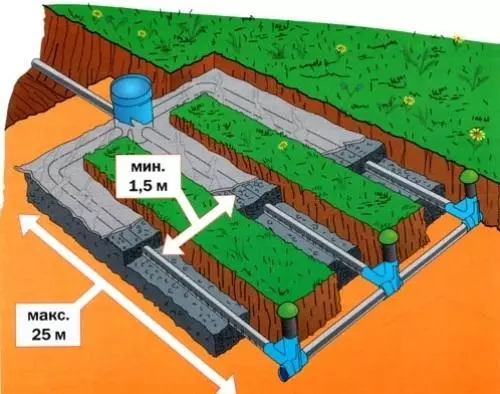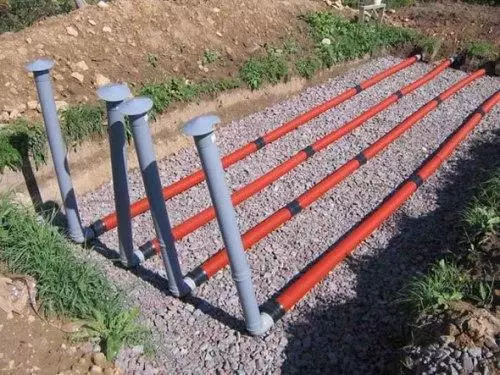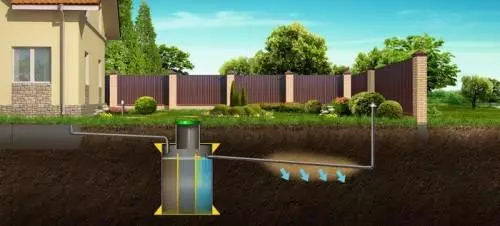
Any error in arranging the septica may have deplorable consequences: pollution of the territory, failure of the system of sewage system, deterioration of living conditions in the house, etc. To avoid a similar "ecological catastrophe", you need to take care of the competent installation of the septica itself, as well as the fields of filtration and drainage system, which are also elements of the system of cleaning sewage drain.
How to make a drainage system of sewage?

The drainage system is a system of perforated pipes, which are also called drains working as one with a system of sewage system at home and septic. From the location of the latter directly depends the depth of the pipe installation. The sewer tube must be installed at a depth of 0.45-0.65 m at an angle of 2-3 °. The septic tank is mounted at a depth of 1.25-2 m, but not deeper. At the location of the tank at greater depth there are difficulties with the process of purifying drainage by anaerobic bacteria.
The perforated pipes of the drainage system must have a diameter of 0.11 m. The diameter of the drain holes located along the pipes depends on their location: in the upper part of the holes, the holes are smaller in diameter, and in the lower larger. This is done so that the drains are evenly distributed over the area. At the beginning of the system, their number is larger, and the diameter of the holes is less, which does not give the deadlines to flow at once. The farther there are holes from the distribution well, the greater the diameter, at the end of the pipe holes are taken at the bottom.
For the proper arrangement of drainage you need to use several simple rules:
- The length of each of the drainage tubes should not be greater than 25 m, ranging from the distribution well to the installation site of the ventilation fungi;
- The distance between adjacent drains should be at least 1.5 m;
- Installation of drainage pipes is carried out at a depth of 1.5 m;
- The trench in which the pipe is placed, in width should be at least 0.5 m, the optimal width is 1 m.
Article on the topic: Step-by-step installation of the air conditioner with your own hands (17 photos)
Filtering field device

The parameters of the filtration field are determined by the type of soil and its ability to self-cleaning.
To arrange such a field, follow the following sequence of work:
- At the bottom of the dug trench, a layer of purified sand with a thickness of approximately 10 cm is added;
- On the sand pillow from above, rubble with a fraction of about 20-40 mm. Thickness of the rubble layer 35 cm;
- On the rubble layer, the drain is stacked and the top is falling asleep on a height of 10 cm. A geotextile film protecting the system is laid on crushed stone;
- The layer of soil is stacked on top.
When conducting the above work, you need to remember some nuances:
- The drainage system should be at a depth of 0.35-1.6 m. At a lesser depth, it can freeze in winter, which will require the installation of an additional insulating layer;
- The pipes of the system must have a slope of 1.5 °;
- To avoid pollution of water in wells or wells, the distance between them and the filtering field should be more than 30 m;
- On the filtration field or near it can not land trees;
- Plots with a drainage system should not be under roads intended for travel transport;
- If the soil absorbs moisture badly (for example, clay soil) in the trench, it must be replaced by a soil to a depth of at least 0.7 m;
- The drainage system should have ventilation in the form of ventilating pipes with a height of at least 0.5 m. From above, these pipes are covered with visors to protect against dust and garbage. The air entering the system through the ventilation pipes allows the purification of drains by anaerobic bacteria, as a result of which the drains are cleaned by 95-98%.
Important to remember! The drainage system during operation requires periodic maintenance, which is to replace the sand-gravel pillow to a new, as well as replacing the soil layer under it. Such service should be carried out once every 6-10 years, which depends on the load workload.
How to take water filtration?

Wastewater, falling into the sewage system, and then to septic, there are several filtering stages:
- Stocks fall into the first septication department where the liquid is defended. This department is equipped with a special membrane that does not pass inside the gases and foam;
- Under the pressure of new stocks, the purified liquid flows into the next septicity department, where impurities are split under the action of special substances. These impurities, reacting with chemicals, go to a weighted state;
- In the last department, the septicity weighted impurities fall into the sediment, and the purified liquid flows into the distribution well, and then in the drain.
Article on the topic: Painting the balcony with your own hands (photo)
A special role in the process of cleaning stocks is played by anaerobic bacteria, which was mentioned above. They are introduced into a septic tank as part of special means and provide a high level of cleaning. In addition, these bacteria perform a protective function, protecting the system from casing.
Please note that the septic tank cannot always break all impurities - some of them accumulate in it, lowering the effectiveness of its work. To clean the septica, it must have a hatch through which the remnants of impurities are removed using an assessing machine. You need to think about the presence of an entrance to the septic tip also in advance, while choosing its location.
For normal operation, septica should be minimized to a rainwater entering it, insoluble impurities, toxic substances, including chlorine. All of them can significantly affect the operation of the Septic, reducing the service life.
